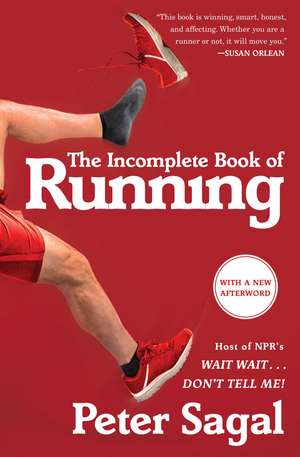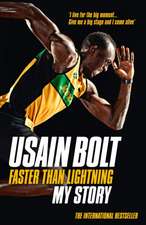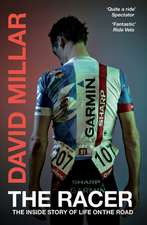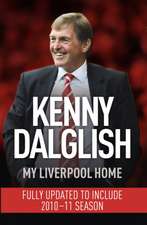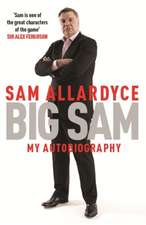The Incomplete Book of Running
Autor Peter Sagalen Limba Engleză Paperback – 18 sep 2019
On the verge of turning forty, Peter Sagal—brainiac Harvard grad, short bald Jew with a disposition towards heft, and a sedentary star of public radio—started running seriously. And much to his own surprise, he kept going, faster and further, running fourteen marathons and logging tens of thousands of miles on roads, sidewalks, paths, and trails all over the United States and the world, including the 2013 Boston Marathon, where he crossed the finish line moments before the bombings.
InThe Incomplete Book of Running, Sagal reflects on the trails, tracks, and routes he’s traveled, from the humorous absurdity of running charity races in his underwear—in St. Louis, in February—or attempting to “quiet his colon” on runs around his neighborhood—to the experience of running as a guide to visually impaired runners, and the triumphant post-bombing running of the Boston Marathon in 2014. With humor and humanity, Sagal also writes about the emotional experience of running, body image, the similarities between endurance sports and sadomasochism, the legacy of running as passed down from parent to child, and the odd but extraordinary bonds created between strangers and friends. The result is “a brilliant book about running…What Peter runs toward is strength, understanding, endurance, acceptance, faith, hope, and charity” (P.J. O’Rourke).
Preț: 93.56 lei
Nou
17.91€ • 18.50$ • 14.90£
Carte disponibilă
Livrare economică 04-18 martie
Specificații
ISBN-10: 1451696256
Pagini: 224
Dimensiuni: 140 x 213 x 15 mm
Greutate: 0.18 kg
Editura: Simon&Schuster
Colecția Simon & Schuster
Notă biografică
Peter Sagal is the host of the Peabody Award-winning NPR news quiz Wait Wait...Don’t Tell Me!, one of the most popular shows on public radio, heard over four million listeners each week. He is also a playwright, a screenwriter, the host of Constitution USA with Peter Sagal on PBS, a one-time extra in a Michael Jackson music video, a contributor to publications from Opera News to The Magazine of the AARP and a featured columnist in Runner’s World. He’s run fourteen marathons across the United States. Sagal lives near Chicago with his wife Mara.
Extras
Preface
In the midpoint of life, I found myself lost, in a dark place. So I tried to figure out exactly how many miles I had run to get there.
There are obsessive runners who record every fraction of every mile in logbooks piled years-high on their shelves, but I, a distracted, undisciplined person who is lucky if he remembers to write down his name on a check, am not one of them. I’ve subscribed to various digital services in recent years that supposedly automatically upload all my mileage to websites for the exercise community, but no service will let me use my preferred log-in password, “IFORGOT.” So let’s try some rough calculation.
I started running at fifteen and pretty soon I was obsessively traversing seven miles of suburban pavement a day, more on the weekends, and I kept that up until the weight loss and hollowed look of my eyes began to freak everyone out, including myself, and then I backed off. So let’s say about two thousand miles for my high school career. I jogged sporadically in college when schoolwork or girls or depression or depression about schoolwork and girls didn’t get in the way, and they got in the way a lot, so let’s just throw on one thousand miles for my entire four years of higher education.
My young adulthood was spent in LA, where sometimes the air was so thick with smog I could imagine seeing the atmospheric particulate matter I had sucked into my lungs coming back out of my nose like a French inhale, so I didn’t run much in those five years. Then, like Kurt Russell, I escaped LA and lived out the last of my twenties in Minneapolis, where the air was cleaner but significantly colder, so my running was pretty limited there as well. Let’s be conservative and say one thousand miles for the whole decade, bringing us up to four thousand, and let’s do the same for my thirties, the years in which I became a parent and got a real job and discovered that telling the mother of my young children that while I completely understood how tired and worn out she was after caring for them all day while I was in the office, I still needed to get a few miles in to improve my mood . . . did not do much for hers. Let’s say another thousand for that busy yet indolent decade. As I approached age forty, my guesstimate at my lifelong running odometer stands at five thousand miles.
And then something changed, a change as significant as any other in my life, and perhaps more. Becoming a husband, father, radio host, they all changed my circumstances, significantly and for the better, at least most of the time. But becoming a serious runner at the age of forty, as a way to forestall the mortality that seemed to be (and of course was) closer than it ever had been, changed who and what I am, physically, emotionally, mentally. I went from being a person who ran to being a runner.
How many miles in the thirteen years since then? Fourteen marathons—that’s 365 miles right there—plus countless half marathons and ten-mile races and 10Ks and even the occasional 5K, plus miles and miles and miles of training for those races, or doingrecovery runs from those races, or just getting out for a run because sitting in the house or office for one second more seemed unbearable.
I have run every single street in my suburb west of Chicago a thousand times, so much so that if somebody remodels their porch, I notice it. Chicago’s Lakefront Trail is a strip of mixed-use recreational pavement that runs for eighteen miles sandwiched between Lakeshore Drive and its namesake, Lake Michigan, and I have run every mile of it so many times that each step of each repetition brings back a specific memory: Here’s the stretch where I ran that frozen half marathon in January 2013. Here’s where my running buddy Chris and I finished our twenty-mile training run in 2006 in such ragged shape that we told ourselves we’d just try to get to the next lamppost, nothing more ambitious than that, and we counted them out in gasps as we stumbled back to where we parked. Here’s the decorative fountain at the midline of the old McCormick Place building that according to Chicago writer Aaron Freeman is the unofficial divider between the northern and southern sections of the path, and thus the divider between White People Exercising and Black People Exercising. Here’s Grant Park, where I skittishly started my first-ever marathon in 2005, and thanks to a polygonal but closed-course map, also where I dragged myself over the finish line four hours and three minutes later. There’s Navy Pier, a god-awful yet inexplicably popular tourist attraction, and, because of some terrible sin committed in a prior life, my workplace for twenty years. Let’s keep going; I spend too much time there as it is.
And of course I’ve run in places other than Chicago. Everywhere, in fact. It’s been almost fifteen years since I went on a trip without packing my running shoes, shirt, shorts, and socks. On my many trips for Wait Wait . . . Don’t Tell Me!, the radio show I’ve hosted since1998, if I didn’t go for a run, I wouldn’t have a chance to get out of the hotel or performance space and see where I was. Once, in a city I won’t name because I don’t want to embarrass Virginia Beach, our hotel was part of the same new mixed-use complex that included our theater. I stepped out of the chain hotel, slowly turned 360 degrees, taking in the Victoria’s Secret and the P.F. Chang’s and the Auntie Anne’s and the generically comfortable and generically welcoming gastropub connected to the generically civic auditorium, and I realized that nothing anywhere in my line of sight gave me a single clue as to where in the United States I might be. So I took off on a run, and ended up in a really shitty part of town next to a rail yard, but at least it was shitty in a charmingly regional way.
Citizens of these United States don’t so much travel as we are processed through space, like some sort of industrialized extruded meat product, human Slim Jims. Metal boxes carry us to processing centers that put us on conveyor belts that put us in metal tubes that take us to other processing centers and conveyor belts that put us in different metal boxes that take us to temporary storage cubicles, many of them with lovely minibars for overpriced sustenance. Like hamsters in Habitrails, we think we’re free, because that’s what the enclosure’s designers want us to think. If we didn’t do something drastic to punch through the walls, we’d never even know we were trapped.
If visiting a city, I would head for the city center, or if in a state capital, I’d orient toward the building with the golden dome. If in a university town, I’d head for the campus and run on the leafy pathways in the quad, then look for the football stadium, and once there, rattle the door handles. Sometimes I got lucky. Once, at the Yale Bowl in New Haven, I returned a kickoff 110 yards for a touchdown, versus fierce if imaginary opposition.
I have seen remarkable things, and passed them at moderate speed. I have seen sea lions at the end of a deserted pier under the Golden Gate Bridge mating, wrestling, or arguing, or—in the manner of humans—all three at once. I have run up the steps of the Philadelphia Museum of Art just like Rocky and every other middle-aged mook in the world, and I have surprised cows on a country road in New Hampshire and Matthew McConaughey on the path around Town Lake in Austin, Texas (neither mooed). I have come upon, almost as a surprise, the Vietnam Veterans Memorial on the National Mall in Washington, DC, at which point I slowed to a walk and descended into it and emerged at the other end, hoping my bare legs and sweaty shirt would imply no disrespect, and ran off again, feeling newly and powerfully blessed I was able to do so. I have run through arboreal forests in Alaska, along volcanic sand beaches in Hawaii, and because of the fortunate circumstances of my birth, many varied and lovely places in New Jersey.
But I have also ended up in ugly industrial strips, like the one outside Virginia Beach and the one north of Charlotte, North Carolina, and I have become lost in endless, anonymous suburban housing developments, and, in Cobb County, north of Atlanta, a bizarre wasteland of shiny empty office towers next to lonely 1950s-era suburban houses on little islands of lawns, victims of a zoning plan devised by lunatic libertarians. I have passed hulking remnants of the industrial past, like the General Electric plant in Schenectady, New York, and felt an odd reverence, as if visiting a giant tomb. I have conducted running expeditions into my own history, running the three miles from my childhood home to my junior high school—a feat I never could have accomplished when I was required to make that journey every day—and once a six-mile mission to the address of my father’schildhood home in Highland Park, Texas, only to find it had been scraped away years prior and replaced by a Greco-columned McMansion. So I just stood in front of the site, put my hand on a tree old enough for my father to have known it, and like he once did, headed off to the northeast at a deliberate pace.
I have stood sweating and panting in front of stores and schools and waterfalls and vistas and garbage dumps. I have run to the tops of hills only to find piled trash and graffiti, or another higher hill beyond, the second in a seemingly infinite rise of obstacles. I have entered the curved streets of new housing developments, like the one I grew up in, and gotten hopelessly lost, as I always worried I would as a child. I have had to end my runs and come back long before I made it anywhere interesting, and I have kept going to get to some fantastic view, only to get back so late I arrived at a cocktail party still sweating into my dress shirt, apologizing to everyone and worrying about the smell.
So: how far is that? We can’t waste too much time, we’ve got a whole book to get through before either of us gets to check Twitter again, so let’s just say: twenty thousand miles, for a lifetime total of twenty-five thousand. I have run more than once around the world. And yet, here I still am.
• • •
To talk about running is to talk about change and the promise of change. Running, as a topic, has a narcissistic focus on the self—its current flaws and future glories. Unlike every single other amateur sport pursued on the planet, we who do it seldom talk about the people who do it very, very well. Imagine a group of golfers who never talk about professional golfers but maybe had heard of this Tiger Woods fellow only because of that strange thing with his wifeand a car crash. Imagine a soccer game in which a player doesn’t think of himself as Lionel Messi every time he manages to elude a defender, or a tennis player who slams a winner that skims the net and doesn’t say to herself, “Beat that, Serena.” But we runners—except for a group of hard-core track nerds—don’t know who won the last Berlin Marathon, let alone the American 10,000-meter championship, and we wouldn’t recognize the names if we were told them, and we don’t really care.IInstead, we talk to ourselves about ourselves and our slow progress.
Every year for the last decade in the United States, some two million people have taken up running, and whether they succeed or don’t, they are all looking for the same thing: change. People run from their problems or toward some idealized solution. Running magazines are filled with these uplifting stories, with before and after pictures of people conquering obesity, illness, injury, loss, or grief, with the first picture showing them splaying out of their seat at a dinner table and the second showing them slim and smiling, holding a race finisher’s medal.
The day before the 111th Boston Marathon in 2007, I was invited to participate on a panel of other first-time Boston marathoners by Runner’s World magazine, for which I soon became a columnist. As we moved down the dais from right to left, each participant told the story of how they conquered whatever obstacles life or overeating or sloth had placed in their way. “I was a fat, unathletic kid,” said the first guy, and then the first woman in the group talked about how she conquered both obesity and asthma, and then some guy actuallytalked about how his cancer—cancer!—had led to the removal of a good part of his brain, and here he was, about to run America’s most prestigious and famous marathon. So, that, and yeah, when he was a kid? Fat. Fatty-fat-fat.
I related my own story, which I’ll get to later in these pages, but yes, indeed, it did involve my young self waddling around and breathing hard whenever I had to climb some stairs, and then my transformation (skipping a few decades here) into a Boston Marathon qualifier. Finally, the mic was passed to Amy Palmiero-Winters, the world’s foremost female below-the-leg-amputee distance runner. She had qualified for Boston (like me, in Chicago the year prior) with a record-setting 3:06 and was looking to run the next day’s race in under three hours, the first-ever breaking of the three-hour barrier by any amputee.
Amy took the mic, looked at the rest of us panelists with a subtle but perceptible glance of annoyance, and then turned to the audience.
“Well,” she said, “I hate to say it, but I wasn’t fat growing up.”
“Imagine what you could have accomplished if you were,” I said.
• • •
Most recreational runners you meet are older, thirty-five and up, leading to the perverse result that it’s often easier to win an age-group award in a small race as a younger runner; just recently I almost burst a lung to take third in my age group in my neighborhood 10K with a time that would have won the 25–29 group. This is because most people need a little waft of mortality to motivate them to run seriously, which often means turning thirty, and sometimes, as in my case, forty. I’ve had, broadly speaking, two running booms in my life—ages fifteen through nineteen or so and ages forty topresent—and both of them were inspired by self-loathing and/or an acute awareness of Time’s Winged Chariot rushing by. One of the most famous runners in the country, Dean Karnazes, began his career as an ultramarathoner on the night of his thirtieth birthday party, when he became so disgusted with himself he stripped to his shorts, started running down the street, and called his wife the next morning from thirty miles away, asking for a pickup.
So running attracts those in need of change, usually a specific kind of alchemical process by which you can become that which we all want to be: (1) thin, (2) healthy, and thus (3) happy. Running, so simple, so available, seems like a magic trick, and just like at magic shows, people want to be thrilled by miracles.
But in the course of writing this book I went through another kind of transformation. I went from being a married father of three young girls to a divorced father of three teenage girls, and the experience has been about as tumultuous and metamorphic as one of those elaborate charts showing you how oil is refined. I have been through heat and pressure and tight spaces and I have come out annealed into something harder and more brittle than I was.
So because running is life, to write about running is to write about life, and to write about my life is to write about that second transformation as well, into darkness and then back out into the light, at a variable pace.
Traumatic family dramas are the most compelling, time-honored genre of entertainment, from Oedipus to Desire Under the Elms to The Force Awakens. It is, however, unpleasant to have to live one, so I will not inflict any of the details of my particular crucible on you, dear reader. But at the same time, the story I tell in the book takes place amid events in my personal life that were traumatic, tragic,and sometimes comically surreal. More than once, I woke from a nightmare in my bed to face the same nightmare in waking life. And during all that time I ran, sometimes poorly and slowly, sometimes as if something terrible were chasing me, sometimes feeling more alone than I had ever felt, sometimes as part of a crowd forty thousand strong. Running preserved me, running distracted me, and running prepared me in ways I hadn’t anticipated for challenges I couldn’t have imagined.
My life changed completely within the space of a single year that started and ended with iterations of the same race. It was the most momentous year of my life, and in many ways the worst, but in retrospect it had to be lived. In the course of telling the story of that single year, I’ll have to go back to my childhood, long before I ever imagined I could run farther than the length of a hallway, and I’ll imagine the day when something, be it mortality, my failing body, or maybe a wayward truck, stops me in my tracks. There are stories from my long-ago days as a happily married man and from more recent times when I was morally certain I would never be either married or happy again.
Like Kurt Vonnegut’s Billy Pilgrim, I am a person unstuck in time. I can be jerked out of the moment completely, by the sight or sound of something that sparks an irresistible memory, or even by my own wandering mind. I can be there talking with you one moment and then I’m a thousand miles and/or ten years away, reliving a particular embarrassment or trauma, or, as is the case more recently, a moment with my children when they were young. Here is the time I crashed a motorcycle. There is the time I toured the Duomo in Florence with my three-year-old daughter, and to keep her from wandering around in the crowd, told her the ceiling had “Papa-attracting paint,”and if she let go of my hand, I would float up and away. Here I am thinking of her gripping my hand with both of hers.
And so this story will leap back and forth, following my thoughts where they go, as I relive a year as hard to describe as it was to live through. All told, it is a story of exertion, of learning, of an atrocity that shook the world, and triumphs that mattered only to me, and most of all, a kind of stubborn determination which, as it turns out, is the only athletic skill fate granted to me, other than my aerodynamic skull.
The story ends with me standing on the same patch of ground I’m standing on when it begins, but everything that could be changed had been changed.
I. In 2017 it was Eliud Kipchoge and Leonard Korir, respectively, which I had to look up just now.
Recenzii
—Susan Orlean
“This is a brilliant book about running, and it’s brilliant even if you never have—and never want to—move faster than a shuffle. Ostensibly, Peter’s subject is the physical activity itself. (Feh, as far as I’m concerned.) In fact the book is a manifesto on the redemption of escape. And, even more so, a meditation on the direction of flight. Whatever you’re running from, you’re running to something else. What Peter runs toward is strength, understanding, endurance, acceptance, faith, hope, and charity.”
—P. J. O’Rourke
“Peter Sagal is the funniest person on radio (quick reminder, I am on television). I enjoy listening to Peter onWait, Wait . . . Don’t Tell Me!on the weekend while chopping vegetables for soup. It will be nearly impossible to do that while reading this book, so if someone could bring me some carrots and onions in half-inch dice, that’d be great.”
—Stephen Colbert
“Peter Sagal’s insightful and open-hearted book about running will make you wish he was your long run buddy. This book not only demonstrates the ways in which running shapes a life, but also how life, in all its beauty and pain, shapes the run. I loved it.”
—Lauren Fleshman
“Look, everything Peter Sagal says he knows is written on an index card supplied to him by a member of his staff. If he, himself, wrote any kind of guide to running, it’d be incomplete.”
—Tom Hanks
Descriere
Peter Sagal, the host of NPR’s Wait Wait...Don’t Tell Me! and a popular columnist for Runner’s World, shares “commentary and reflection about running with a deeply felt personal story, this book is winning, smart, honest, and affecting. Whether you are a runner or not, it will move you” (Susan Orlean).
On the verge of turning forty, Peter Sagal—brainiac Harvard grad, short bald Jew with a disposition towards heft, and a sedentary star of public radio—started running seriously. And much to his own surprise, he kept going, faster and further, running fourteen marathons and logging tens of thousands of miles on roads, sidewalks, paths, and trails all over the United States and the world, including the 2013 Boston Marathon, where he crossed the finish line moments before the bombings.
In The Incomplete Book of Running, Sagal reflects on the trails, tracks, and routes he’s traveled, from the humorous absurdity of running charity races in his underwear—in St. Louis, in February—or attempting to “quiet his colon” on runs around his neighborhood—to the experience of running as a guide to visually impaired runners, and the triumphant post-bombing running of the Boston Marathon in 2014. With humor and humanity, Sagal also writes about the emotional experience of running, body image, the similarities between endurance sports and sadomasochism, the legacy of running as passed down from parent to child, and the odd but extraordinary bonds created between strangers and friends. The result is “a brilliant book about running…What Peter runs toward is strength, understanding, endurance, acceptance, faith, hope, and charity” (P.J. O’Rourke).
